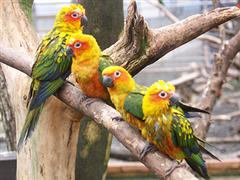Conure - Jandaya
Jenday Conure, Janday Conure Scientific Name: Aratinga jandaya
Sat, 14th June, 2025 - 5:08 am GMT
Sponsor Ads:

Alternative Name
Jenday Conure, Janday Conure Scientific Name: Aratinga jandayaBasic Info
The Jandaya Conure is larger than most, averaging 12 inches in length. The primary color of the Jandaya Conure is green, with the head, throat and upper breast being a gorgeous yellow-orange. The area around the eye is white and the iris is a gray-brown color in the adults. Young Jandayas have dark eyes. The wings are primarily green, with blue flight feathers. The lower back of the Jandaya Conure is orange-red, and its tail is olive green with blue edges. The legs of the Jandaya Conure are gray, while the bill is black. In addition to eye color immature Jandayas can be distinguished by the pale yellow coloring on their heads.
Health
As with most parrots, always offer the Jandaya Conure fresh fruits and vegetables, as well as foods such as beans and cooked eggs. Water should be changed daily, and it is equally important to remove fresh food quickly so it does not spoil. The Jandaya Conure only needs a vitamin supplement if on a strictly seed diet. The size of the cage should be sufficient to accommodate their wings and to give them room to play. Usually, a 24-inch by 24-inch by 36-inch cage will do. Larger cages also work well, but it is important that the space between the bars is not more than 3/4 of an inch wide so they do not get stuck. A variety of perches should be provided to give their feet exercise. Feeding dishes should not be placed directly below perches. If they are placed directly below a perch food and water will get spoiled. Toys are necessary, since Conures are avid chewers. In addition they should be provided with a dish for bathing and if this is not possible they should be sprayed with water regularly. Conures are prone to a vitamin K deficiency and a bleeding disorder, but with the proper nutrition, both of these can be avoided. Conures are also good flyers, and require more clipping, but never too much, so the bird will fly gently to the floor. Breeding It is impossible to sex Jandaya Conures by sight; so surgical sexing or blood testing is necessary. The female will start to produce eggs at approximately 2 years of age. They will usually begin breeding in February. The average clutch contains 3 to 4 eggs, which take 26 days to incubate. Babies will usually fledge within 50 days. The chicks will sometimes stay with the parents for a short period after leaving the nest. The Jandaya Conure can sometimes have two broods in a year.Habitat
Usually seen around forest clearings, sometimes near coconut palms and edges of the rain forestBehavior
The Jandaya Conure, also known, as the Jendaya Conure is a very beautiful parrot indeed! They can make a wonderful addition to the family with the proper training. Not as much is known about the Jandaya Conure in the wild, because they are usually seen singly, making it more difficult to study them. They are not necessarily shy, and they can certainly be heard by their loud calls. If you choose to make a Jandaya Conure a family member, you can reduce their noise level with proper training, which is relatively easy with this particular Conure. But they may not be well suited for apartments. For this reason it is important to offer them a variety of food in captivity in addition to their regular diet. The Jandaya Conure loves to play making them fun to watch. At one time the Jandaya Conure used to be much more common in captivity than the Sun Conure, but now the Jandaya Conure is a lot less common than the Sun Conure.Origin
BrazilHistory
The Jandaya Conure is native to northeastern Brazil, and is usually seen around forest clearings, sometimes near coconut palms and edges of the rain forest. They are relatively common in the wild, and are one of the few species that has benefited from forest clearing.Common Foods
In the wild, The Jandaya Conure will eat seeds and nuts, as well as rice, corn, smashed cashews and fruits, including mango.Sponsor Ads:
As folks might have suspected, not much survives except roaches, and they don't carry large enough packets fast enough... -- About the Internet and nuclear war.
Conure - Jandaya
Coded by: BGID® | ALL RIGHTS RESERVED Copyright © 2000-2025
Disclaimer | Privacy | Report Errors / Contact | Credits
















